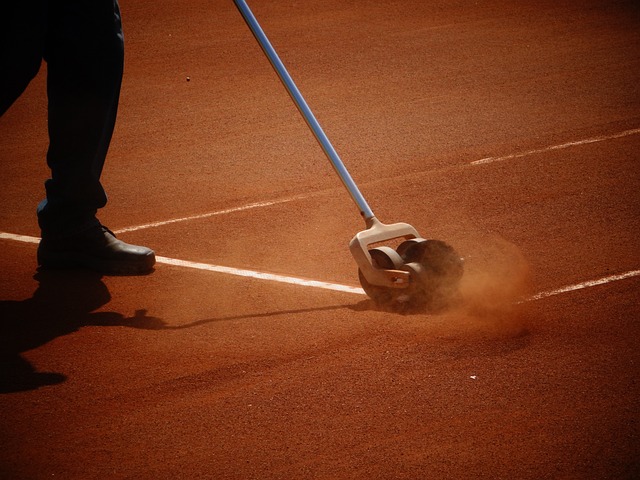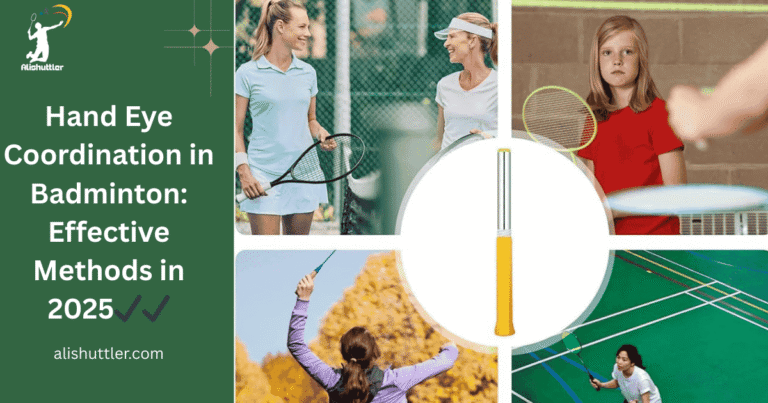In the United States, the size of a badminton court conforms to the specifications set forth by the Badminton World Federation. In the case of doubles play, the court is 44 feet long and 20 feet wide.
In singles, the width of a badminton court size is reduced to 17 feet, but the length remains unchanged. The net is 5 feet tall in the middle.
On each side, there is a short service line that is 6 feet 6 inches from the net. At the back of the court, there is a back boundary line.
These regulations ensure consistent and equitable play, whether on rec centers, schools, or gyms. Understanding the proper court dimensions provides for a smooth setup and allows all players to respect and play by the rules.
The following sections teach you more about court marking, layout and equipment.
What Defines a Badminton Court?
A badminton court is not simply a flat surface with some lines and a net. Its dimensions, markings, and surface influence not only the style of play but player movement and effective strategy.
Dimensions
A typical badminton court has a rectangular shape. It’s marked by a central net that divides it down the middle, with each side reflecting the other. How these measurements and court markings harmonize is key on every rally, every serve, and every return.
Here are some things that really define a badminton court. Let’s take a look at the precise measurements, markings and areas that make play possible with such great rhythm and continuity.
1. Official Court Length (Feet/Meters)
A regulation badminton court is 44 feet (13.41 meters) long from baseline to baseline. This length is used in singles and double play. This constant length ensures that all players, regardless of height or reach, are presented with the same difficulty in court coverage.
It can be in Los Angeles, it doesn’t matter! For reference, tennis courts are 78 feet long. By comparison, badminton courts are smaller, but they demand faster reactions and more nimble footwork.
It’s not just about fairness. It’s about the game itself. The shuttlecock’s flight is unforgiving to the environment. On the shorter courts, rallies seem cramped. On longer ones, it’s hard to determine depth and shot placement.
At competitive levels, especially in professional play, even a minor miscalculation in court length affects the players’ timing. This results in a lot of poorly judged clears or smashes. To satisfy tournament and league regulations, most indoor badminton venues in the U.S. Adhere closely to these official lengths.
2. Standard Court Width (Feet/Meters)
Width varies based on if it’s singles or doubles play. For doubles, it is 20 feet (6.1 meters) and for singles, 17 feet (5.18 meters). In doubles, it stretches out to 20 feet (6.1 meters). The change in width is arguably one of the most obvious differences on court.
You can clearly identify it by the outermost side boundary lines. An expanded court in doubles increases the need for lateral movement, rapid directional changes, and effective cooperation with your partner.
Players should constantly be working to protect the alleys – out in singles, in in doubles. In singles, the narrower width lets players focus on deep shots and straight drives, as there’s less angle to defend.
Doubles games, with the full width, reward effective court coverage and fast reflexes, especially during flat exchanges near the net.
3. Singles vs. Doubles: Line Truths
Marking the court with lines provides players the information on where to serve, when a rally is in or out, and where to position themselves. The singles court uses the inner sidelines and the full length of the court. Conversely, the doubles court uses the outer sidelines and has a shorter back service line for serving.
The doubles back service line is located 2 feet and 4 inches (0.72 meters) from the baseline. Understanding these lines is crucial not only for scoring but for service as well.
For doubles, serves need to land between the short service line (6.5 ft / 1.98 m from the net) and the back service line. For singles serves, you sometimes have to serve all the way back to the baseline.
Often new players will have misconceptions. They miss their serves into the wrong area or foot fault by stepping onto the wrong line, giving points away.
4. Net Height: The Mid-Court Barrier
Badminton nets should be high enough to reach 5 feet 1 inch (1.55 meters) at the posts. At the mid-court, the net height drops to 5 feet (1.52 meters). That little droop is intentional as well as necessary.
With a higher net, net shots and smashes become much more difficult to perform. A lower net swings the game advantageously towards power hitters! It still serves as an important physical and symbolic barrier.
Each shot crossing the net must pass this height, making players balance risk and reward. Proper net tension is crucial, so the shuttle does not go under or get stuck. During tournaments, referees inspect the net’s height prior to the beginning of play.
5. All The Lines: A Quick Guide
- Baseline: Marks the back boundary for singles and doubles.
- Sidelines: Define the width, with inner lines for singles and outer for doubles.
- Short Service Line: 6.5 feet (1.98 meters) from the net, where serves must pass.
- Back Service Line (Doubles): 2 feet 4 inches (0.72 meters) inside the baseline.
- Center Line: Splits the service courts left and right.
- Service Boxes: Created by the short service, center, and side lines.
Each line has a job. The inner service lines help prevent any sneaky serves. Using sidelines to tell whether a shot is in or out. The baseline prevents the game from extending too far.
Familiarity with these lines allows players to create their serves, anticipate close calls, and steer clear of game-destroying mistakes.
6. Singles Service Box Secrets
The singles service box is quite long and narrow—defined by the center line, short service line, singles sideline, and baseline. Players are required to serve diagonally, with the shuttle landing within the opponent’s service box.
Precision is essential as the box’s orientation favors skill and placement. An astute serve can even drive the receiver deep allowing a more strategic shot to be played on the next rally.
7. Doubles Service Box Details
Doubles service boxes are shorter and wider than singles. As a result, they extend from the short service line to the back service line, and from the center line to the outer sideline. All serves are required to land within these boxes.
The reduced length makes flick serves or high serves much more risky, so most players will choose a low, short serve. The best doubles servers vary their placement to make returners’ guesses more difficult.
8. Why Ceiling Height Counts Big Time
Badminton might arguably be the fastest racquet sport in the world, with high, arching clears followed by quick, explosive smashes. Low ceilings restrict the types of shots played and require a player to adjust their strategy.
Whatever the case, the majority of U.S. Clubs and gyms shoot for ceilings to be no less than 30 feet (9 meters). Anything less endangers everyone—shuttles could strike gas pipes or light fixtures—and confines the game’s pace and approach.
Enough ceiling height allows everyone to play their best game, whether that’s making a high defensive lift and playing it safe or sending down an offensive smash.
9. Essential Run-Off Space Around
Run-off space is the area between the outer court lines and any walls or hazards. 2 feet (0.61 meters), with 6.5 feet (2 meters) or higher the norm at facilities. Even 2 feet is the bare minimum.
This additional space helps prevent injuries as players pursue shots near the edge of the court. It aids in avoiding injuries from slips or running into obstacles. Clubs looking to build new courts should aim for spacious configurations to allow gameplay to develop without risk.
10. Total Area Needed: Plan Right
About a full doubles badminton court with safety run-off area. When you account for space to move around, space for equipment, and space for spectators, the suggested total area quickly grows.
Access paths should avoid cordoning off courts or creating blind spots if multi-use gyms must accommodate storage. Smart planning ensures that everyone—from the guy playing on his break to the Olympic hopeful—has space to improve their game.
Why Size Dictates Your Game
The dimensions of a badminton court are not just arbitrary figures. Every dash, streak, and measure determines the play and direction of the game. It affects a character’s movement speed, stamina, available tactics and even game outcomes. With a closer look at these nuances, players of every age and ability can take their game to the next level.
How Dimensions Shape Movement
Court size determines the importance of each dribble. In singles, the court is 5.18 meters narrower, making players run more side-to-side and requiring them to depend on quick footwork. Doubles courts, measuring 6.10 meters wide, allow for more angle and require great synchronicity and awareness from partners.
The same with a longer court, which, at 13.41 meters, creates longer rallies and requires more run. The area from the net to the service lines is equally critical. It dictates how far back or far forward a player is able to serve, influencing player movement and shot selection.
On smaller courts, such as that for junior play, players cut with an acute angle. Even though they go over a smaller area, accuracy really pops off the page!
Strategic Play: Using The Space
Players use court size to their edge. A wider court in doubles means more room to pull opponents off-balance with cross-court shots. Knowing the distance to the service line lets players drop the shuttle just over the net or aim deep.
Spotting gaps and judging court size quickly helps in outsmarting rivals. Coaches often work drills that mimic real match spacing for this reason.
Court Size and Player Stamina
Larger courts require longer sprints and greater endurance. Singles players typically condition themselves to be fast and endure lengthy rallies. In doubles, the additional width requires even more explosive sprints.
Smaller courts, as seen in junior games, emphasize skill over athleticism. Elite players are able to customize their workouts to suit whatever court size they may be playing on.
Ensuring Fair, Regulated Matches
Standardized court dimensions ensure all matches are played in a level environment. If even one court is a little off, down to inches, it can change the entire game. That’s why organizations like the Badminton World Federation impose heavy handed regulations.
Incorrectly marked courts have sparked protests and even full match replays at major championships.
My Take: Small Changes, Big Impact
Just a few inches can make the difference between a long rally’s momentum shifting or a player’s strategy towards the net. I’ve played on courts that were a little bit different.
All the players who recognize these trends and adapt ahead of the pack have a distinct advantage. Studying each square foot of the court leads to big rewards at all levels.
Setting Up Your US Court
Setting up your badminton court in the United States requires special attention to space, court lines, and orientation. Whether for singles or doubles, the court is 44 feet in length and 20 feet in width. Its well-defined borders are 4 cm in width.
Make sure there is a minimum of 1 meter space on each side. Maintain 1.5 meters of free space in the back to encourage active play and avoid congestion. A centerline divides the court at the exact center point creating two sides of equal length of 6.7 meters from the center down.
For doubles, the width is reduced to 17 feet. The average service line is 10 feet long, and the long service line is 22 feet long from the net. The net itself is 5 feet high at center and a little over 5’ at the posts. For most indoor courts you’ll need a ceiling height of 24 to 29 feet minimum.
The rules are on their side, and for good reason—accuracy is critical for fair play and a well-run game. The real struggle sometimes lies with cramped areas, rough turf, or maintaining markings in inclement conditions. Good measuring and marking prevents lines that don’t match up or incorrect serves.
Marking Lines: Get It Right
- Measure court dimensions with a tape and mark corners.
- Snap chalk lines between points for straight edges.
- For permanent lines, use court marking paint or masking tape.
- Double check all key spots—service lines, centerline, and boundaries.
For this, you’ll want a reel tape, chalk, straightedge, and durable marking paint or tape. Take your time—the marks are important and hasty lines or markings can ruin the game before it even starts.
Maintain lines. Clean, restripe lines in poor condition, or remove them.
DIY Court: A Weekend Project?
Most of them attempt to build a court on their own. Pickup string, a surveyor’s measuring tape, paint, and a net kit. Choose a level, open space and remove any sharp or hazardous materials.
DIY COURT INSTALLATION TIP: Mark each line carefully, then install the posts. Uneven terrain or inclement weather can put a damper on things, but with the proper setup, sand or grass can be used.
Design to your space. Add personal touches, such as lighting or benches, to customize for your space.
Small Space Badminton Solutions
Not everyone has access to a large backyard space. Whether you’re on a concrete driveway or a wooden patio, portable nets and mini sets give you the freedom to play wherever.
Modify the infraction—reduce game time or use doubles to accommodate more participants. Playing in confined environments develops quickness of reflexes and footwork.
Multi-Use Courts: Smart Design Tips
It’s common for schools and parks to configure courts for multiple uses. You can paint removable lines or use flexible flooring to include badminton without sacrificing basketball or volleyball.
Flexible materials make maintenance a cinch, providing a safer and easily replaceable experience. One easy and inexpensive way to mark courts is to have different colored tape for each sport.
Backyard Badminton: Casual Fun
With your own backyard court, it’s as simple as gathering your friends and family together. Choose nets and racquets designed for the outdoors.
Playing outdoors increases health and provides a healthy, casual alternative for soothing in the sunshine. Experimenting with night games using string lights or incorporating music can amp up the fun.
Court Surfaces & American Choices

American Badminton court surfaces have evolved over the years as an understanding of players’ needs have developed, and trends in the sport have influenced surfaces used. Choosing the right court surface is about more than simply creating a place to play. It determines how athletes run, how they’re protected, and how they play the game.
Today, the best surfaces in America represent a unique blend of heritage, purpose and flair.
Popular US Court Materials
| Material | Gameplay Feel | Maintenance Needs | Durability | Cost | Use Case |
|---|---|---|---|---|---|
| Hardwood | Smooth, fast | Moderate | High | High | Pro, Schools |
| Synthetic Acrylic | Balanced, soft | Low | High | Medium-High | Multi-sport, Pro |
| Rubber | Cushioned | Low | Medium | Medium | Gyms, Rec |
| Asphalt/Concrete | Hard, basic | Low | High (outdoor) | Low | Parks, Outdoor |
Hardwood courts remained the standard surface in US gyms and schools. Players seem to enjoy the speed and rock-steady, firm feel. Synthetic acrylic has taken over in popularity, particularly for multi-sport use, and it holds up to heavy play.
Rubber provides superior traction and cushioning, reducing the risk of injury, but requires more upkeep. Asphalt and concrete are the more affordable choices for outdoor or budget courts, though they’re harder surfaces. For the average riders, court surfaces the choice is limited to cost, how they’re utilized, and if they require shock absorption.
The Logic Behind Court Colors
Court surface color is more important than people realize. Bright colors, such as blue or green, serve to increase shuttle visibility and reduce glare. A solid, thick court perimeter allows players to judge angles and respond quickly.
It’s blue and green, reflecting current US trends for indoor courts, though some clubs are incorporating more custom colors to represent their team’s pride. The correct color minimizes distraction and maximizes mood enhancement on court.
Indoor vs. Outdoor Surface Facts
Indoor courts typically have hardwood, acrylic or rubber surfaces to allow for consistent play and year-round usage. Outdoor courts tend to be more asphalt or concrete, designed to withstand sun and rain.
For environments that are more humid or hot, surfaces need to be able to withstand rapid changes in weather and not deteriorate quickly. Both surfaces require maintenance—indoor courts require daily cleaning and periodic polishing, while outdoor courts require sealing and crack-filling.
My Preferred Surface for Play
In all of my play, hardwood provides the best combination of speed and touch. It’s a solid surface to play on, it has good grip and is very comfortable for long matches.
Hardwood does require a bit of maintenance, but with the play it easily makes up for it. Even so, experimenting with a rubber surface versus an acrylic surface can help demonstrate what works best for your game.
Variations and Comparisons
Badminton courts have different configurations. Each alteration in scale or form dramatically changes the way the game is played. Understanding the differences enables players to choose the appropriate court, adapt their game, and strategize effectively.
Rec Play vs. Pro Standards
While recreational courts commonly stick to the basic footprint of pro courts, they don’t always adhere to the same dimensions. A standard pro court, used in the Olympics, has set dimensions: 44 feet long by 20 feet wide for doubles, and 44 feet by 17 feet for singles. Many rec centers follow these specifications.
Yet for the rest, their home might be a much more compact or even ad-hoc area, such as in community gymnasiums or school spaces. In terms of skill building, playing on a true-size court allows players to acclimate to the official court dimensions and the actual pace of game play.
When space is limited, a lot of recreational players will set up tape lines or cones to simulate a pro-style layout. That allows them to train to almost pro standards, even in a more compact space!
Mini Badminton: Big Fun Small Court
Mini badminton is designed for children or limited environments. The court measures only 34 feet long, and the net is hung lower to accommodate kids’ height. With this arrangement, the game is more enjoyable and equitable for kids.
Great for families looking for a fast-paced, convenient game on the backyard or playground! The smaller court increases the pace of play and reduces the barrier to entry, making it ideal for family gatherings.
Badminton vs. Tennis Court Size
| Sport | Singles Size (ft) | Doubles Size (ft) |
|---|---|---|
| Badminton | 44 x 17 | 44 x 20 |
| Tennis | 78 x 27 | 78 x 36 |
Therefore, tennis courts are considerably larger than badminton courts. This size discrepancy leads to tennis favoring stamina and long sprints, whereas badminton emphasizes explosion and fast footspeed.
Badminton vs. Pickleball Court
Pickleball courts are 44 by 20 feet, the same size as a badminton doubles court. Pickleball nets are definitely lower! The bat-and-ball nature of the game with various paddles adds an exciting new pace and feel to rallies.
Some sports complexes have started marking courts with lines for both sports, allowing athletes to transition from one sport to another more fluidly.
Any US Regional Quirks?
While all US clubs will largely adhere to the same standard court size, there are some modifications you’ll find in certain regions. For example, school gyms in older buildings might run courts a few feet short, or local groups might use whatever space is open.
Look into local standards to avoid any surprises. Common courtesy should always prevail.
Common Court Size Questions
Badminton court size is a frequent source of confusion, even for established players. Getting the facts straight helps keep games fair and enjoyable, whether you play in a gym, a backyard, or a multi-use sports hall. The stated dimensions for a badminton court is 43.5 feet (13.24 meters).
However, other sources round this up to 44 feet. Each half is 22 feet (6.7 meters) wide. A net, taut at 5 feet 1 inch (1.55 meters) at the posts, separates the two halves and sags a bit in the middle. Service courts are 12.72ft (3.88m) wide and 8.3ft (2.53m) long. They sport lines that distinctly draw four service areas.
Can Tennis Lines Work Okay?
Playing badminton on a tennis court with tennis lines creates issues. Tennis courts are significantly larger and their lines do not correspond with badminton’s stricter specifications. When court markings compete, players are left confused as to where the lines end and a boundary begins.
This creates the potential for disagreements and ambiguity. To allow for proper play, it’s ideal to mark out official badminton lines with tape or paint. Always use the proper dimensions to prevent problems with scoring as well as safety.
Is Ceiling Height Flexible?
In badminton, ceiling height is very important. The preferred minimum is 26 feet (8 m). An unanticipated consequence of lower ceilings is that high shots are limited and players shoot differently.
Some courts do their best to compensate with angled lighting or modified play. The game is at its best when it gives you room to breathe above.
Outdoor Play: Same Rules Apply?
Additionally, outdoor courts ought to be held to the same size standards as indoor courts. Uniform court sizes allow players to transition from place to place without changing their form.
Wind, sun, and uneven ground may affect play, but the fundamentals of fair play stay consistent.
Are Measurements Truly Universal?
Are Measurements Really Universal? Some diagrams use 44 feet as the length, which is a rounded figure. The actual measurement is 43.5 feet.
Although regional differences are few and far between, abiding by the official sizes ensures that play is consistent and doesn’t lead to a confusing experience.
What If My Space Is Odd?
In cramped or difficult areas, aim to preserve the same proportions, even if you are unable to replicate all measurements exactly. Bring portable nets with you and use tape to mark lines.
Making minor adjustments to the width or length is often acceptable. Maintaining net height and service areas to as close to their intended specifications are key in making the game true to form.
Keeping Your Court Game-Ready

Keeping your badminton court well-maintained goes beyond appearance. It’s about creating safe, fair and consistent play environments. Players need real confidence, and playing a game on a court that has crisp lines and a smooth, even surface helps foster that confidence while keeping the game fair.
Proper maintenance prevents injuries. A clean court prevents tripping hazards like debris and worn areas that can cause injuries to even the most skilled players. Maintain at least a one meter space on either side. Leave at least a meter and a half at the back of the court to prevent damage and ensure playability.
Next, let’s consider the key elements of court maintenance.
Line Care for Lasting Clarity
- Use outdoor-grade paint or tape for marking lines.
- Check lines before every game for fading or chips.
- Clean away dust or dirt that may hide markings.
- Re-Evaluate Line Drawings Redraw or repaint lines as soon as they lose clarity.
- Choose weatherproof and non-slip materials for marking.
Keeping lines clear is imperative. They outline the boundaries, direct the servers, and prevent unnecessary arguments. Frequent touch-ups help keep lines crisp, improving the quality of play and players’ concentration.
Surface Upkeep Basics for Longevity
One type of care or maintenance will not work for every surface. Indoor wood floors require regular dusting and mopping, while outdoor concrete or asphalt courts will typically require sweeping and pressure washing.
Address cracks and chipped areas as soon as they appear to prevent larger issues. Placing mats at entrances reduces the amount of dirt brought onto the court. High-quality court materials are tougher against the elements and use, creating better and safer conditions while playing.
Net Care and Tension Tips
Check tension and height of net before playing. The height of net must be 1.524 meters in the middle, posts should be fixed and solid. Change out worn or sagging nets quickly to ensure that rallies remain competitive.
Maintaining a proper net helps ensure games run smoothly and players stay on task.
How Court Standards Evolved

Badminton court standards have certainly come a long way. They’ve evolved alongside the game’s expansion, equipment advances, and input from athletes from youth through the collegiate ranks. From its inception, regulation sought to guarantee matches were competitive.
It was to make sure that courts had the possibility of fitting in both a single and a double. Today’s modern court is a rectangular area, divided by a net, that measures 13.4 meters (44 feet) long. Boundary lines and equipment lines define areas for service and rally play.
The net is 1.55 m (5 ft 1 in) high at the sidelines. Midway through, it sinks a bit to 1.524 meters (5 feet). Additionally, these figures along with the width and marking specifications provide a uniform playing surface for amateur and professional play alike.
A Look Back: Court Changes
Between the late 1800s and early 1900s, guidelines and court sizes changed frequently. The Pune rules established some of the first rules, but it was England’s 1893 rules that cemented the rectangular shape and field markings.
The video game can be played with up to four players per team. Two or four players turned out to be the ideal number for clean, speedy play. From small clubs to the Olympic Games, each major tournament played a tremendous role in shaping and solidifying today’s standards.
Courts received a few minor adjustments, such as line thickness or net height, to accommodate contemporary aesthetics and player input.
Modern Gear’s Impact on Space
Racket and string technology accelerated the game’s pace and power. Rec players often string lower (80-110 N). Pros tend to go higher for added control.
As equipment became lighter and faster, the dimensions of the court were unchanged, but the pace of the game became much faster. This doesn’t eliminate the old standby rectangle, but gear decisions today greatly affect players’ usage of space.
Future Court Size Thoughts?
Future court size considerations are important if tennis gear or player style were to change dramatically. Court sizes could be adjusted again.
These recent works are a testament to this tenuous equilibrium between tradition and innovation, reverence and reclamation. Changing court standards helps make sure the game remains exciting, but equitable.
Moving forward, players need to remain engaged and be part of discussions on what should happen next.
Conclusion
Badminton court size defines each match, whether they’re rallies at the local gym or games in your own backyard. In the US, a regular doubles court is 44 feet long and 20 feet wide. Singles courts are a bit narrower. Outdoor arrangements may adjust these lines, but remaining close ensures good competition and enjoyable matches.
Court lines, net height, surface — these elements all make a huge difference to the unique feel of the sport here. You can organize it in a city recreation center or a residential garage. So understanding your court size ensures a level playing field for all! Have additional questions or tips on setting up to share? Leave your comments in the space provided beneath, or contact us for additional court expertise.
Frequently Asked Questions
What is the standard size of a badminton court in the United States?
This means that a standard US badminton court is 20 feet wide and 44 feet long for doubles. For singles matches however, the width is cut down to 17 feet. These dimensions are in accordance with official U.S. Badminton specifications.
How much space do I need around my court for safe play?
Ensure a minimum of 5 feet of unobstructed space around every edge of your court. This provides players adequate space to move safely and it aids in injury prevention as well.
Can I set up a badminton court in my backyard?
Absolutely, provided your backyard is relatively flat and big enough—ideally at least 30 by 60 feet. This accommodates the size of the court and additional room for playing.
What surfaces work best for US badminton courts?
What surfaces work well for US badminton courts US hardwood floors are the ideal indoor surface. Outdoors, even smooth concrete or asphalt is adequate. Of course, you should always avoid very rough or uneven surfaces to lower the chance of injury.
Are there any differences between indoor and outdoor court sizes?
Are there any differences between indoor and outdoor court sizes. Though, outdoor courts may require additional space for windbreaks or fencing.
How high is a badminton net supposed to be?
The badminton net should be 5 ft high in the middle and 5 ft 1 in at the posts. This is true for singles and doubles play.
Why do court dimensions matter for competitive play?
Proper dimensions are crucial to guarantee fair play and competitive scoring. Since they are in accordance with official tournament measurements, players are able to train and compete with confidence in their match courts.






